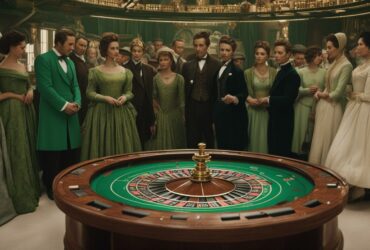If you’re a fan of casino games, then you’re probably familiar with the classic game of roulette. This popular game has been around for centuries and is enjoyed by millions of players around the world. But have you ever wondered how many balls are used in roulette? In this section, we’ll explore the mechanics of the game and provide you with a comprehensive understanding of how many balls are used in this exciting casino game.
Roulette is a game that involves a spinning wheel with numbered slots and a small ball. The objective is to predict which slot the ball will land in. Whether you’re a seasoned player or a beginner, understanding how many balls are used in roulette is essential for mastering the game and making informed bets. So let’s dive into the basics of the game and explore the different types of roulette to get a better understanding of this classic casino game.
Throughout this section, we will use SEO relevant keywords, including “how many balls in roulette,” “roulette ball count,” and “number of balls in roulette,” to provide you with the most informative and comprehensive understanding of the topic.
The Basics of Roulette
Before we dive into the number of balls used in roulette, let’s first establish the basics of the game. Roulette is a classic casino game that involves a spinning wheel with numbered slots and a small ball. In a typical roulette game, the wheel has 37 or 38 slots, depending on the version of the game being played.
The objective of roulette is to predict which slot the ball will land in after the wheel stops spinning. To make a prediction, players place their bets on a table layout that mirrors the numbers and colors of the wheel. You can bet on a single number, a combination of numbers, or even the color of the slot.
Once all bets have been placed, the croupier spins the wheel and drops the ball onto it. As the wheel slows down and the ball bounces around the slots, players hold their breath in anticipation, hoping that the ball will land on their chosen number or color.
The roulette ball is a critical element of the game, as it determines which slot is the winning one. Now that we have gone through the basics, let’s look into more detail at the different versions of roulette and the number of balls used in each game.
Single Ball Roulette
When it comes to roulette, the traditional version is played with a single ball. This means that during each spin, only one ball is released onto the roulette wheel to determine the outcome. The counting roulette balls may seem trivial, but it has a significant impact on the game’s dynamics. The objective of single ball roulette is to predict the number or color that the ball will land on.
The single ball format is the most commonly played roulette ball quantity version in both land-based and online casinos. It offers a classic and straightforward experience, with easy-to-understand betting options. Additionally, the roulette ball quantity used in single ball roulette provides a stable and predictable game, which may be more appealing to some players.
Overall, single ball roulette is a great option for those who enjoy a more traditional gambling experience. If you prefer a simplified version of the game, then this might be the perfect option for you. However, if you are looking for a more exciting version, then you should consider playing multi-ball roulette, which we will cover in the next section.

Multi-Ball Roulette
While traditional roulette games use only one ball, some variations have introduced multi-ball gameplay. This exciting twist involves simultaneous use of multiple balls during each spin. This can increase the fun factor and give players higher chances of either winning or losing with each spin.

How Many Balls on a Roulette Table?
Playing roulette with more than one ball can result in multiplying the amount of action happening in each game round, but how many balls are used on a roulette table? The varying number of balls used in multi-ball roulette depends on the specific game variant, but two, three, or more balls during each spin are common occurrences. By allowing several balls to be in play, the game’s dynamics change, and players have additional betting options to consider, inviting them to use different gameplay strategies.
Number of Balls in Multi-Ball Roulette
Multi-ball roulette is an exciting variation of the traditional roulette game and can use two, three, four, or even more balls during each spin, depending on the particular game variant. The increased number of balls creates additional betting options and can potentially lead to higher payouts for lucky players.
One of the most popular versions of multi-ball roulette is Double Ball Roulette, which as the name suggests, uses two balls in every spin. In this game, players can increase their chances of winning by placing side bets on whether both balls will land on odd or even numbers, or whether both balls will land on black or red numbers. Another interesting variation is Triple Bonus Spin Roulette, which uses three balls and has bonus slots with multipliers that can lead to massive wins.
Players should note that the specific variant of roulette they choose to play will determine the number of balls used during each game. Therefore, before placing any bets, it is crucial to understand the rules and regulations of the particular game being played. Knowing the number of balls in play can also help players develop a unique strategy and increase their chances of winning.
Conclusion
Knowing the number of balls in play is crucial to understand roulette variants, making informed bets, and improving your overall experience. Whether you prefer the traditional single ball or the excitement of multi-ball roulette, understanding the basics of the game will streamline your gameplay.
The number of balls used in roulette depends on the variant of choice. Some versions may use two, three, or even more balls during each spin, introducing additional betting options and strategies for players to consider.
So, next time you decide to play roulette, remember to inquire about the ball count to prevent surprises. Now that you know how many balls in roulette, you can concentrate on placing your bets and spinning the wheel.
Mastering roulette requires practice, patience, and a thorough understanding of the game mechanics, including how many balls are used. Keep in mind that the number of balls you play with can affect your overall odds of winning or losing.
Thus, in conclusion, understanding the roulette ball count, number of balls used in roulette, and its variants is an essential component of mastering the classic casino game. So, gear up, place your bets, and spin the wheel for a thrilling gaming experience!
FAQ
How many balls are used in traditional roulette?
Traditional roulette is played with a single ball.
Are there variations of roulette that use multiple balls?
Yes, some versions of roulette introduce multi-ball gameplay, where multiple balls are used during each spin.
How many balls can be used in multi-ball roulette?
The number of balls used in multi-ball roulette can vary, with some versions using two, three, or even more balls.
What is the purpose of using multiple balls in roulette?
Using multiple balls adds excitement to the game and provides additional betting options and strategies for players to consider.
How does the number of balls affect the gameplay and odds in roulette?
The use of multiple balls in roulette can increase the chances of winning or losing with each spin, creating a more dynamic gaming experience.
Is it necessary to know how many balls are used in roulette?
Understanding the number of balls used in roulette is important for players to make informed bets and adapt their strategies accordingly.
Which version of roulette should I choose if I prefer single ball gameplay?
If you prefer the traditional single ball gameplay, you can opt for the classic roulette variant found in most land-based and online casinos.
Can I find multi-ball roulette in both land-based and online casinos?
Yes, multi-ball roulette can be found in some land-based casinos and online gambling platforms that offer this exciting variation.













Leave a Reply